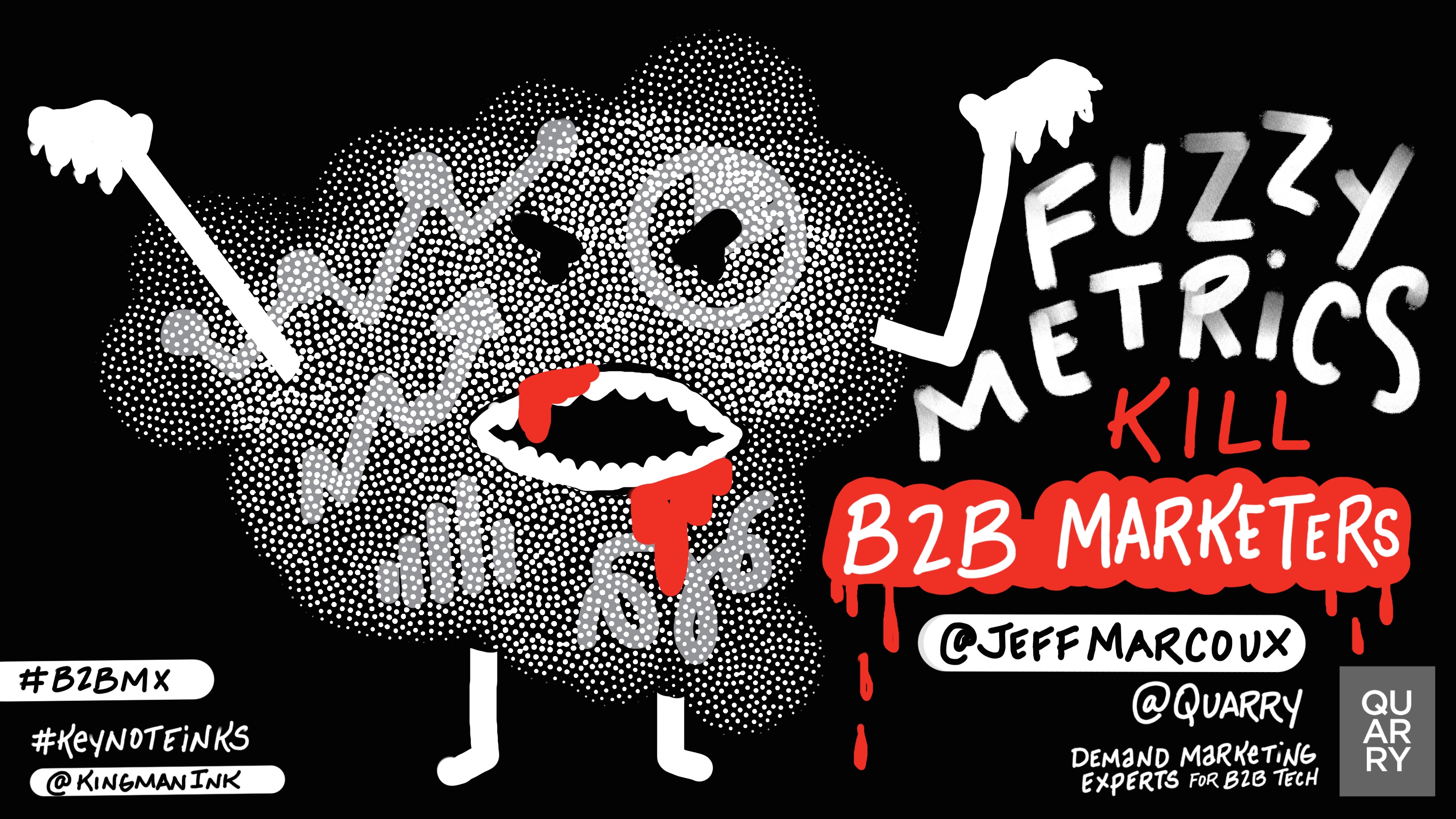B2BMX 2023 Day 1 & 2 Recap: Using Technology To Empower Human Connection
- Written by Karen Axelton, Contributing Writer
- Published in Industry Insights
Is artificial intelligence (AI) coming for your job? The promise and power of AI was a key topic of discussion at B2B Marketing Exchange 2023 (#B2BMX). With five tracks including ABM In Action Live, Content2Conversion, Demand Gen Summit, Sales Impact Summit and Go-To-Market Strategy, #B2BMX gave marketers plenty of insights and actionable ideas to help them tackle today’s biggest challenges. Read on for some highlights from day one and two of the event.
Marketing AI: Tomorrow’s Promise, Today’s Reality
Breathe easy: While AI has great potential, it’s still a long way from making marketers obsolete. That’s the message Pam Didner of Relentless Pursuit delivered in her keynote, “Marketing + The Machine: Sizing Up AI’s Emerging Impact On Efficiency Vs. Risks To Creativity.”
“There are no marketing robots yet,” Didner said, noting that we’re still at the very beginning of the AI curve. Today’s “narrow” AI, such as Siri or Alexa, can do one task competently and learn. Next will come artificial general intelligence, or AGI, which can perform any intellectual task humans can. Once we reach AGI, Didner cautioned, we’ll quickly advance to artificial superior intelligence, or ASI, which can be much smarter than humans.
AI can be applied in everything from creative to lead management to relationship management and more. For example, AI writing assistant tools can help you build creative briefs or write first drafts. Being clear about your workflow and how AI can help streamline it will make the concept less overwhelming, said Didner, recommending four steps for applying AI in your company:
- Start by exploring AI features in your existing platforms;
- Next, fill in gaps you identify by purchasing AI-based tools;
- Merge your workflows and processes with AI platforms; and
- Create a machine learning model internally by working with your data team to create predictive analytic models to answer specific questions.

“AI is a game changer, but it’s not yet taking over people’s jobs,” Didner said. As an example, she shared AI-generated cover art created by Cosmopolitan art directors. Far from a quick process, the final cover required the human designer to spend dozens of hours giving the AI increasingly detailed directives to get the desired results. “Embrace AI and test it,” Didner said. “Then when management asks if you should use it, you’ll have an informed point of view to share.”
Phyllis Davidson of Forrester continued the AI discussion in “Are We Ready to Trust the Machines? Building A More Intelligent Content Stack With AI, Automation & Analytics.” AI has the potential to create content intelligence that can narrow the gap between customers’ soaring expectations for personalized experiences and marketers’ currently limited content engine capabilities.
Davidson noted marketers are leaving money on the table by not using all the AI features of their current tech stack. Echoing Didner, she advised auditing the AI capabilities in your existing systems that touch content, then looking for ways to expand AI use cases.
For example, “taxonomy and metadata are key to content intelligence, but humans are notoriously bad at taxonomy,” Davidson said. AI can tag content and generate metadata to improve search and help your sales team easily find the content they need when they need it, reducing content waste.
Davidson also advised looking for places across the content lifecycle where you can introduce more automation and phase out manual workflows.
“Automation can unlock efficiency in our content engines, helping us pull humans out of more mundane activities and deploy them in a more strategic way,” she explained.
Finally, use AI to enhance content data and analytics capabilities. These are typically immature in most B2B organizations, Davidson said, causing a competitive disadvantage in CX.
Content intelligence has the power to drive success in marketing and revenue, Davidson said.
“This is not about AI taking over humans’ jobs — it’s about a partnership that will build the content intelligence you need to keep fine-tuning that hyper-personalized experience,” she continued. “There will be plenty for humans to do, because we have to train the content engines and use their insights to inform planning.”
New Challenges, New Approaches
Sales and marketing teams face a changing landscape that includes longer sales cycles, smaller deal volume and buying committees often numbering 25 people or more, said Jeff Marcoux, CMO of Bombora, in his keynote, “Well, There Goes My Buyer’s Journey.”With an average of 27 touches per contact needed to close a sale, that can add up to almost 700 touches. How can marketers orchestrate those interactions for success?
Getting in front of buyers in the earliest stages of their journey — while they’re still doing their own research — is key, Marcoux said, but so is what he dubbed full-funnel marketing.
“Most clients stop marketing at the top of the funnel, but marketing can influence every stage of the journey,” he explained. For example, monitoring customer accounts for red flags can reduce churn, while tailoring outreach to the right buying group members at the right time can keep prospects engaged.

Most important, marketing and sales must work together to identify friction throughout the buying journey and eliminate it. “Incremental changes at the bottom of the funnel can have massive impact,” Marcoux said.
Some 40% of deals tank because buyers choose not to act, Marcoux said. Often, FOMU, or “fear of messing up,” is behind this indecision. Buyers don’t want to make the wrong decision, so they do nothing. Marcoux noted that storytelling can address this issue — a theme on which Ciara Ungar of Ciara & Co. elaborated.
In her talk, “What The Pitch? Secrets To Telling A Brand Story That Sticks,” Ungar explained that storytelling is the secret sauce of the world’s most successful companies. “Stories get people to open up to our ideas,” said Ungar. But too many marketers fall short when it comes to storytelling.
“People don’t buy products because you tell them to, they buy products because you move them to,” explained Ungar, citing three common marketing pitfalls:
-
Being too focused on numbers. “People don’t buy the best product – they buy the one they can understand fastest that are communicated the clearest.”
-
Cognitive bias, or assuming prospects know as much about our product as we do, we communicate at a higher level than they can understand. “You need to weed out everything that’s not necessary,” Ungar said.
-
Making ourselves the center of the story. “Don’t be like the bad date who only talks about themselves,” Ungar warned. “Your product needs to be a tool in the customer’s journey to success.”
How can marketers rethink their approach to build understandable, simplified messages about what matters most to the customer? Start by defining the “why” of your business, being as specific as you can. (Not, “We sell software that helps people automate processes,” but “We sell peace of mind that creates a better future.”)
“Understanding your ‘why’ is central to being able to communicate your story in a way that resonates,” Ungar noted. Next, dive deep with empathy to view the customer’s pain points from their perspective. Finally, play a supporting role; elevate the customer and their success.

The Human Factor
“At the end of the day, B2B is human to human,” Ungar contended. “We make decisions based on emotional drivers fortified by logic. We can’t tap into that logic if the emotional side shuts down. Storytelling breaks down barriers so your audience can understand and digest the complex information you’re sharing with them.”
The ability to forge human-to-human connections is one that spies and top salespeople share, according to Jeremy Hurewitz of Sell Like A Spy. In his presentation, “Sell Like A Spy: Business Development Lessons & Communication Strategies From The World Of Espionage,” Hurewitz drew from experts in espionage to share lessons for sales teams.
“At the heart of espionage is the idea of connection, and that’s also at the heart of any good salesperson’s tradecraft,” he explained. “It’s about connection, not deception.” Like salespeople, spies have to forge a bond with their prospects and persuade them over a long sales cycle.
“Often in sales we don’t take enough time to get to know that individual and what makes them tick,” noted Hurewitz. No matter who you’re approaching, you can find a kernel of humanity in them to build a connection upon. Exposing something about yourself can also build trust. “Vulnerability breeds intimacy; humanity breeds credibility.”

Flattering a prospect, sharing gossip, asking for help or simply letting an awkward silence persist until the prospect fills it can all elicit information that can help make the sale. Record details on every interaction with a prospect — “their mood, their favorite sports team, what they ate,” Hurewitz advised. Sales is a high-turnover industry, and memorializing this information ensures it isn’t lost when a sales rep leaves.
Ultimately, Hurewitz reminded his audience, “People buy from those they like. Make yourself vulnerable and showcase your humanity to overcome challenges within the context of any sale.”
Personalization: The Next Generation
“If you’re not trying to actively enhance your customer journey, you’re doing a disservice to your organization and the relationship you’ve built with your customers,” contended David Morris of NYCAP3D in “The Undeniable & Foreseeable Merge Of Customer Experience & Web3 Integration.” Marketers ready to take the next step in customer experience should explore the promise of photogrammetry, a technique that uses photos to create 3D models, maps, landscapes and interactive environments.
Photogrammetry is widely used in the gaming and special effects industries, but forward-thinking marketers are now experimenting with it. “The best way to humanize your experience-based marketing campaigns is to personalize them,” said Morris. Scanning customers’ bodies and creating 3D avatars “gives customers the creative autonomy to share their stories and experiences on their own terms.”
Product visualizations, product demonstrations, virtual try-on experiences and other interactive experiences all gain new depth with photogrammetry. It can power immersive advertising, 3D billboards, 3D event way maps and retail installations, among other use cases. “Free swag is boring, emails are overwhelming. This is a way to create emotional shopping experiences,” said Morris. While the technique is still very new, Morris said, getting started with it today can position your brand as a leader in Web3 and CX.
We have one more day left in Scottsdale! Stay tuned for our Wednesday recap, and check out our top quotes from day one and two!


